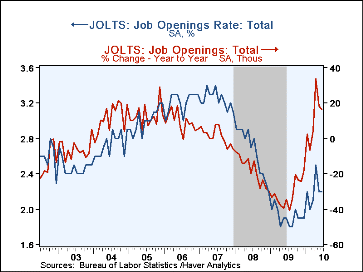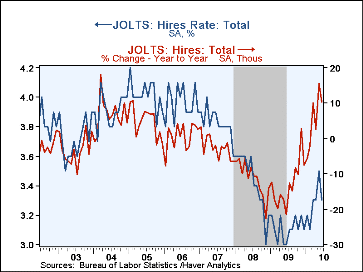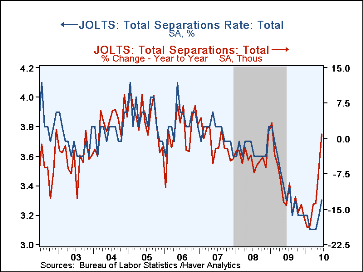 Global| Aug 11 2010
Global| Aug 11 2010JOLTS: U.S. Job Openings Steady During June
by:Tom Moeller
|in:Economy in Brief
Summary
The Bureau of Labor Statistics reported that their latest reading of labor market conditions held steady after earlier deterioration. The Job Openings & Labor Turnover Survey (JOLTS) indicated that the job openings rate during June [...]
 The Bureau of Labor Statistics reported that their latest reading of labor
market conditions held steady after earlier deterioration. The Job Openings
& Labor Turnover Survey (JOLTS) indicated that the job openings rate during
June held at 2.2% versus the April high of 2.5%. Nevertheless, the rate remained
improved from the recession low of 1.8% The job openings rate is the number
of job openings on the last business day of the month as a percent of total
employment plus job openings. Job availability was roughly unchanged after a
sharp May decline but it was up 16.6% versus June '09. Last year job
availability fell 17.8% following a 29.7% decline during 2008.
The Bureau of Labor Statistics reported that their latest reading of labor
market conditions held steady after earlier deterioration. The Job Openings
& Labor Turnover Survey (JOLTS) indicated that the job openings rate during
June held at 2.2% versus the April high of 2.5%. Nevertheless, the rate remained
improved from the recession low of 1.8% The job openings rate is the number
of job openings on the last business day of the month as a percent of total
employment plus job openings. Job availability was roughly unchanged after a
sharp May decline but it was up 16.6% versus June '09. Last year job
availability fell 17.8% following a 29.7% decline during 2008.
The private-sector job openings rate slipped to 2.3% but remained improved from 2.0% during all of last year. The level of job openings rose 15.8% y/y and reflected roughly a more-than doubling of factory openings as well as a 14.9% increase in leisure & hospitality. The lower openings rate translated into a lower hires rate of 3.3% but a 10.3% increase in overall hiring. Private sector hires grew 9.8%. This was led by a 20.7% rise in factory sector jobs and an 8.2% increase in construction employment. The hires rate is the number of hires during the month divided by employment. The government sector's hiring rate was a modest 1.4%.
The job separations rate rose to 3.3% from the series' low of 3.1% in April. I was its highest since September. The actual number of separations also rose sharply for the second month and by 1.0% y/y. However, job separations in the private sector fell 4.0% y/y. Separations include quits, layoffs, discharges, and other separations as well as retirements. The layoff & discharge rate alone rose to 1.6%, as the actual number of layoffs fell 8.5% y/y after a 12.6% increase during 2009. The private sector layoff rate was 1.6% and it rose to 1.5% in government.
The JOLTS survey dates only to December 2000 but has followed the movement in nonfarm payrolls, though the actual correlation between the two series is low. A description of the Jolts survey and the latest release from the U.S. Department of Labor is available here and the figures are available in Haver's USECON database.
| JOLTS (Job Openings & Labor Turnover Survey) | June | May | April | June '09 | 2009 | 2008 | 2007 |
|---|---|---|---|---|---|---|---|
| Job Openings, Total | |||||||
| Rate (%) | 2.2 | 2.2 | 2.5 | 1.9 | 1.9 | 2.2 | 3.1 |
| Total (000s) | 2,937 | 2,939 | 3,302 | 2,519 | 2,531 | 3,078 | 4,378 |
| Hires, Total | |||||||
| Rate (%) | 3.3 | 3.5 | 3.3 | 3.0 | 37.3 | 41.1 | 45.9 |
| Total (000s) | 4,254 | 4,581 | 4,292 | 3,856 | 48,649 | 56,082 | 63,234 |
| Layoffs & Discharges, Total | |||||||
| Rate (%) | 1.6 | 1.5 | 1.4 | 1.7 | 20.7 | 17.7 | 16.5 |
| Total (000s) | 2,034 | 1,904 | 1,760 | 2,224 | 27,683 | 24,589 | 22,606 |
Tom Moeller
AuthorMore in Author Profile »Prior to joining Haver Analytics in 2000, Mr. Moeller worked as the Economist at Chancellor Capital Management from 1985 to 1999. There, he developed comprehensive economic forecasts and interpreted economic data for equity and fixed income portfolio managers. Also at Chancellor, Mr. Moeller worked as an equity analyst and was responsible for researching and rating companies in the economically sensitive automobile and housing industries for investment in Chancellor’s equity portfolio. Prior to joining Chancellor, Mr. Moeller was an Economist at Citibank from 1979 to 1984. He also analyzed pricing behavior in the metals industry for the Council on Wage and Price Stability in Washington, D.C. In 1999, Mr. Moeller received the award for most accurate forecast from the Forecasters' Club of New York. From 1990 to 1992 he was President of the New York Association for Business Economists. Mr. Moeller earned an M.B.A. in Finance from Fordham University, where he graduated in 1987. He holds a Bachelor of Arts in Economics from George Washington University.








